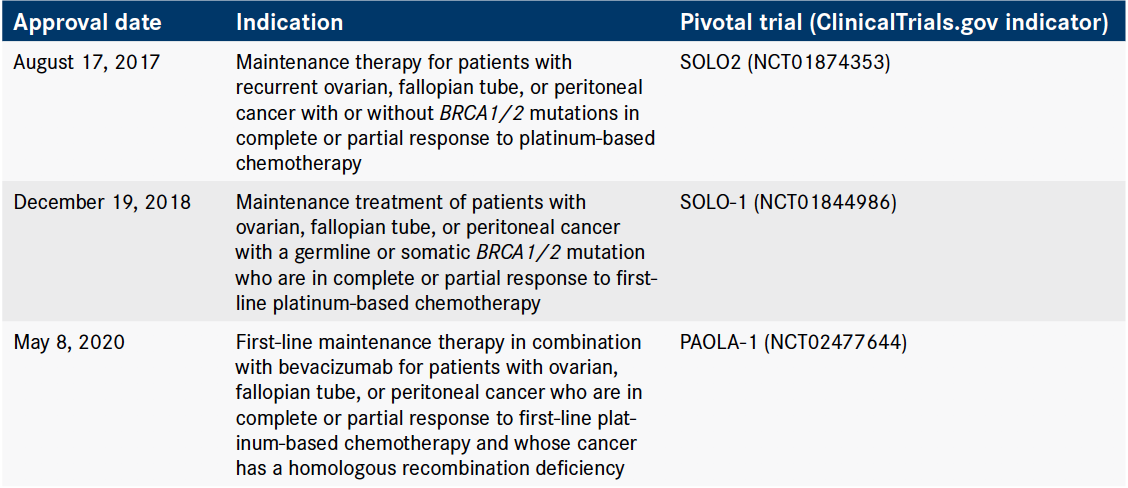Publication
Article
Oncology Live®
PARP Inhibitor Therapy Options Are Transforming Landscape in Ovarian Cancer
Author(s):
PARP inhibitors have fundamentally changed our therapeutic algorithms in ovarian cancer, even as their use continues to evolve.
Kristin K. Zorn, MD

The era of precision medicine has started to make an impact in the treatment landscape for gynecologic cancers. However, epithelial ovarian cancer along with fallopian tube and primary peritoneal cancer remain among the deadliest histologies of this tumor type. Poly-ADP ribose polymerase inhibitors (PARPi) were first approved for use in ovarian cancer, ushering in a new class of drugs for patients with this relatively rare cancer. These agents have fundamentally changed our therapeutic algorithms, even as their use continues to evolve.
Olaparib (Lynparza) was the first PARPi approved by the FDA, in December 2014, for the treatment of patients with recurrent ovarian, fallopian tube, or primary peritoneal cancer with a germline BRCA1/2 mutation who have received 3 or more lines of chemotherapy. Additional indications have followed (Table).1-3
Table. Olaparib Maintenance Indications for Ovarian Cancers1-3

Importantly, in updated data, the median progressionfree survival (PFS) on the olaparib arm of SOLO-1 (NCT01844986) has not been reached; the PFS curves reflect patient status multiple months past discontinuation of the drug after 2 years.2 In addition, recent results demonstrate an overall survival (OS) prolongation of 13 months in SOLO2 (NCT01874353) in favor of olaparib.4
Olaparib is available in 100- or 150-mg tablets with a recommended starting dose of 300 mg twice daily. Recommended dose reductions are 250 mg and 200 mg. Dose reduction frequently requires a new prescription.
In December 2016, the FDA approved rucaparib (Rubraca) for the treatment of patients with recurrent ovarian, fallopian tube, or primary peritoneal cancer with a germline or somatic BRCA1/2 mutation who have received 2 or more prior regimens of chemotherapy, based on results of the ARIEL2 trial (NCT01891344).5 This was followed in April 2018 by the approval for maintenance therapy for patients with recurrent ovarian, fallopian tube, or peritoneal cancer regardless of BRCA mutation status with complete or partial response to platinum-based chemotherapy, based on data from the ARIEL3 trial (NCT01968213).6
Rucaparib is available in 200-, 250-, and 300-mg tablets with a recommended starting dose of 600 mg twice daily. Recommended dose reductions are 500 mg twice daily, 400 mg twice daily, and 300 mg twice daily. Dose reduction frequently requires a new prescription.
Michael Birrer, MD, PhD

Data from the NOVA trial (NCT01847274) led to the March 2017 approval of niraparib (Zejula), the third PARPi for the treatment of ovarian cancer and the first approved for the maintenance therapy of patients with recurrent ovarian, fallopian tube, or peritoneal cancer regardless of BRCA status with complete or partial response to platinum-based chemotherapy.7 Additional indications include the following:
- treatment of patients with recurrent ovarian, fallopian tube, or peritoneal cancer whose disease is associated with homologous recombination deficiency after 3 or more prior chemotherapy regimens (based on the QUADRA trial [NCT02354586]8; October 2019); and
- maintenance therapy for patients with ovarian, fallopian tube, or peritoneal cancer who are in complete or partial response to first-line platinum-based chemotherapy (based on the PRIMA trial [NCT02655016]9; April 2020).
Niraparib is available in 100-mg capsules with a recommended starting dose of 300 mg daily unless the patient weighs less than 170 pounds or has a platelet count of less than 150,000, in which case 200 mg daily is the recommended starting dose. Recommended dose reductions from the 300-mg daily starting dose are 200 mg daily and 100 mg daily. Recommended dose reductions from the 200-mg daily starting dose are 100 mg daily and through to discontinuation. Dose reductions do not require a new prescription.
Of note, veliparib is a fourth PARPi in development for which data were presented in 2019 from a frontline trial in ovarian, fallopian tube, or peritoneal cancer in combination with standard chemotherapy with or without maintenance veliparib (VELIA; NCT02470585).10 Although the trial showed an improvement in PFS for the maintenance veliparib arm, the agent is not FDA approved.
The most common adverse effects for this entire class of drugs include nausea, fatigue, and myelosuppression. Niraparib is notable for an increased risk of both mild and severe thrombocytopenia, leading to the dosing guidelines based on starting platelet count. In addition, although olaparib and rucaparib monitoring guidelines recommend a monthly complete blood count, guidelines for niraparib recommend weekly counts for the first month followed by monthly thereafter for the first year.
Although much attention has been paid to the risk for myelodysplastic syndrome (MDS) and acute myeloid leukemia (AML) with PARPi use, it has been difficult to delineate causation in patients with heavy pretreatment with DNA-damaging chemotherapy. Current estimates are that 1% to 2% of patients on PARPi will develop this complication, although a recent update of the SOLO2 trial showed an 8% risk of MDS/AML in the olaparib arm when cases during and after the safety follow-up period are combined, although the placebo arm in the study had a 4% risk.4
PARPi Use Expands Across Tumor Types
Importantly, the role of PARPi is rapidly expanding in other cancers. Olaparib is currently approved for use in HER2-negative breast cancer with a germline BRCA1/2 mutation (January 2018); maintenance therapy for metastatic pancreatic cancer with a germline BRCA1/2 mutation (December 2019); and metastatic castration-resistant prostate cancer with a germline or somatic mutation in 1 or more of 15 homologous recombination repair genes, including BRCA1/2 and ATM (May 2020). Rucaparib is currently approved for metastatic castration-resistant prostate cancer with a germline or somatic BRCA1/2 mutation and prior androgen receptor and taxane therapy (December 2019). Talazoparib, a PARPi that is not currently approved for ovarian cancer, is approved for HER2-negative advanced or metastatic breast cancer with a germline BRCA1/2 mutation (October 2018).11
For ovarian, fallopian tube, and peritoneal cancer treatment, many questions remain about the optimal use of PARPi. For example, the triage of patients to PARPi maintenance versus bevacizumab is a topic of active discussion. Further, as patients increasingly have been treated with PARPi in the frontline setting, the drugs’ role in recurrence must be better defined, especially regarding switching from one PARPi to another and combination therapy with antiangiogenic and immunotherapy agents.

References
- Pujade-Lauraine E, Ledermann JA, Selle F, et al; SOLO2/ENGOT-Ov21 Investigators. Olaparib tablets as maintenance therapy in patients with platinum-sensitive, relapsed ovarian cancer and a BRCA1/2 mutation: a double-blind, randomised, placebo-controlled, phase 3 trial. Lancet Oncol. 2017;18(9):1274-1284. doi:10.1016/S1470-2045(17)30469-2
- Moore K, Colombo N, Scambia G, et al. Maintenance olaparib in patients with newly diagnosed advanced ovarian cancer. N Engl J Med. 2018;379(26):2495-2505. doi:10.1056/NEJMoa1810858
- Ray-Coquard I, Pautier P, Pignata S, et al; PAOLA-1 Investigators. Olaparib plus bevacizumab as first-line maintenance in ovarian cancer. N Engl J Med. 2019;381(25):2416-2428. doi:10.1056/NEJMoa1911361
- Poveda A, Floquet A, Ledermann JA, et al. Final overall survival (OS) results from SOLO2/ENGOT-ov21: a phase III trial assessing maintenance olaparib in patients (pts) with platinum-sensitive, relapsed ovarian cancer and a BRCA mutation. J Clin Oncol. 2020;38(suppl 15):6002. doi:10.1200/JCO.2020.38.15_suppl.6002
- Swisher EM, Lin KK, Oza AM, et al. Rucaparib in relapsed, platinum-sensitive high-grade ovarian carcinoma (ARIEL2 part 1): an international, multicentere, open-label, phase 2 trial. Lancet Oncol. 2017;18(1):75-87. doi:10.1016/S1470-2045(16)30559-9
- Coleman RL, Oza AM, Lorusso D, et al; ARIEL 3 Investigators. Rucaparib maintenance treatment for recurrent ovarian carcinoma after response to platinum therapy (ARIEL3): a randomised, double-blind, placebo-controlled, phase 3 trial. Lancet. 2017;390(10106):1949-1961. doi:10.1016/S0140-6736(17)32440-6
- Mirza MR, Monk BJ, Herrstedt J, et al; ENGOT-OV16/NOVA Investigators. Niraparib maintenance therapy in platinum-sensitive, recurrent ovarian cancer. N Engl J Med. 2016;375(22):2154-2164. doi:10.1056/NEJMoa1611310
- Moore KN, Secord AA, Geller MA, et al. Niraparib monotherapy for late-line treatment of ovarian cancer (QUADRA): a muticentre, open-label, single-arm, phase 2 trial. Lancet Oncol. 2019;20(5):636-648. doi:10.1016/S1470-2045(19)30029-4
- Gonz.lez-Martin A, Pothuri B, Vergote I, et al; PRIMA/ENGOT-OV26/GOG-3012 Investigators. Niraparib in patients with newly diagnosed advanced ovarian cancer. N Engl J Med. 2019;381(25):2391-2402. doi:10.1056/NEJMoa1910962
- Coleman RL, Flemin GF, Brady MF, et al. Veliparib with first-line chemotherapy and as maintenance therapy in ovarian cancer. N Engl J Med. 2019;381(25):2403-2415. doi:10.1056/NEJMoa1909707
- Hematology/oncology (cancer) approvals & safety notifications. FDA. Updated August 6, 2020. Accessed August 12, 2020. https://bit.ly/3iUuRep
























%20(2)%201-Recovered-Recovered-Recovered-Recovered-Recovered-Recovered-Recovered-Recovered-Recovered-Recovered-Recovered-Recovered-Recovered-Recovered-Recovered-Recovered-Recovered.jpg?fit=crop&auto=format)
%20(2)%201-Recovered-Recovered-Recovered-Recovered-Recovered-Recovered-Recovered-Recovered-Recovered-Recovered-Recovered-Recovered-Recovered-Recovered-Recovered-Recovered-Recovered.jpg?fit=crop&auto=format)
